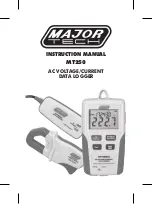
DEWE-43A
TECHNICAL REFERENCE MANUAL
3.1. Hardware revisions
DEWE-43V
Initial version
DEWE-43A
Added isolated CAN ports
DEWE-43A ISO-POWER
Added isolated power supply
3.1.1. Analog input configuration:
Block diagram of analog input (all analog inputs are identical):
Image 1: Block diagram of analog input
The high input impedance (10MΩ ground referenced) has no distortion influence on the measured
signal.
3.1.2. ADC:
The DEWE-43A uses 8 delta-sigma A/D converters. If you sample with a data rate of 102.4 kS/s, the ADC
actually samples the input signal with 13.1072 MS/s (multiply the data rate with 128) and produces 1-bit
samples which are applied to the digital filter. The filter expands the data to 24-bits and rejects signal
parts greater than 51.2 kHz (Nyquist frequency). It also re-samples the data to the more conventional
rate of 102.4 kS/s. A 1-bit quantizer introduces many quantization errors to the signal. The 1-bit, 13.1072
MS/s from the ADC carry all information to produce 24-bit samples at 102.4 kS/s. The delta-sigma ADC
converts from high speed to high resolution by adding much random noise to the signal. In this way the
resulting quantization noise is restricted to frequencies above 100 kHz. This noise is not correlated with
the useful signal and is rejected by the digital filter.
ADCs can only represent signals of a limited bandwidth. The maximum frequency you can represent is
the half of the sampling rate. This maximum frequency is also called Nyquist frequency. The bandwidth
between 0 Hz and the Nyquist frequency is called Nyquist bandwidth. Signals exceeding this frequency
DEWE-43A V20-2
8/38









































